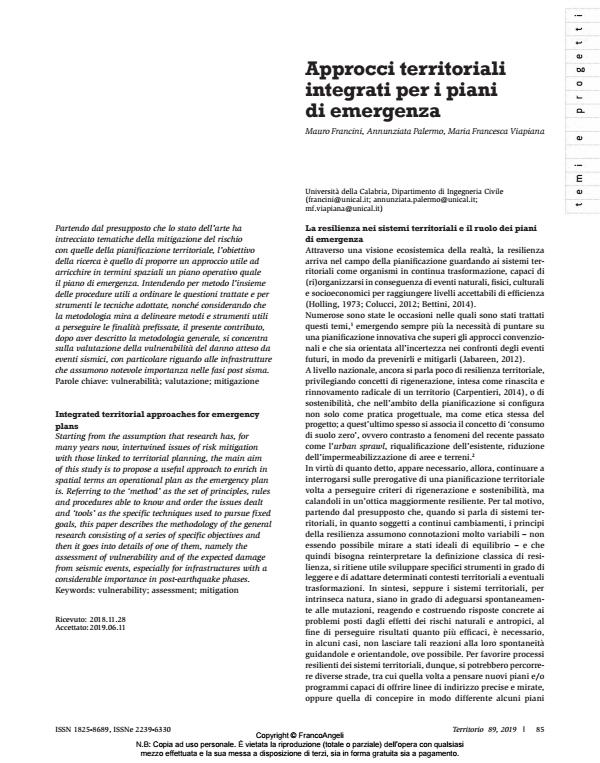Integrated territorial approaches for emergency plans
Journal title TERRITORIO
Author/s Mauro Francini, Annunziata Palermo, Maria Francesca Viapiana
Publishing Year 2019 Issue 2019/89
Language Italian Pages 6 P. 85-90 File size 130 KB
DOI 10.3280/TR2019-089011
DOI is like a bar code for intellectual property: to have more infomation
click here
Below, you can see the article first page
If you want to buy this article in PDF format, you can do it, following the instructions to buy download credits

FrancoAngeli is member of Publishers International Linking Association, Inc (PILA), a not-for-profit association which run the CrossRef service enabling links to and from online scholarly content.
Starting from the assumption that research has, for many years now, intertwined issues of risk mitigation with those linked to territorial planning, the main aim of this study is to propose a useful approach to enrich in spatial terms an operational plan as the emergency plan is. Referring to the ‘method’ as the set of principles, rules and procedures able to know and order the issues dealt and ‘tools’ as the specific techniques used to pursue fixed goals, this paper describes the methodology of the general research consisting of a series of specific objectives and then it goes into details of one of them, namely the assessment of vulnerability and of the expected damage from seismic events, especially for infrastructures with a considerable importance in post-earthquake phases.
Keywords: Vulnerability; assessment; mitigation
- Computational Science and Its Applications – ICCSA 2021 Priscilla Sofia Dastoli, Piergiuseppe Pontrandolfi, pp.665 (ISBN:978-3-030-86969-4)
- Computational Science and Its Applications – ICCSA 2022 Workshops Priscilla Sofia Dastoli, Piergiuseppe Pontrandolfi, Francesco Scorza, Simone Corrado, Antonello Azzato, pp.253 (ISBN:978-3-031-10544-9)
Mauro Francini, Annunziata Palermo, Maria Francesca Viapiana, Approcci territoriali integrati per i piani di emergenza in "TERRITORIO" 89/2019, pp 85-90, DOI: 10.3280/TR2019-089011